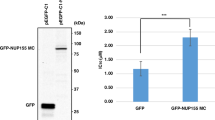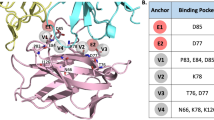Abstract
Specific inhibitors of protein phosphatase 2A (PP2A) mediate anticancer effects by augmenting the tumor-killing activity of natural killer (NK) cells. In this study, new PP2A inhibitors, aminocytostatins A–E, were isolated from Kitasatospora sp. MJ654-NF4 and structurally characterized. Aminocytostatins are derivatives of cytostatin, which is a specific PP2A inhibitor isolated from the same organism, and aminocytostatins have a characteristic amino group within the lactone moiety. Compared to cytostatin, aminocytostatin A showed a stronger inhibitory activity against PP2A in vitro and augmented the tumor-killing activity of NK cells in vivo. Furthermore, a docking model was generated to demonstrate the favorable activities of aminocytostatin A.
This is a preview of subscription content, access via your institution
Access options
Subscribe to this journal
Receive 12 print issues and online access
$259.00 per year
only $21.58 per issue
Buy this article
- Purchase on Springer Link
- Instant access to full article PDF
Prices may be subject to local taxes which are calculated during checkout








Similar content being viewed by others
References
Brautigan DL. Protein Ser/Thr phosphatases-the ugly ducklings of cell signalling. FEBS J. 2013;280:324–45.
Shi Y. Serine/threonine phosphatases: mechanism through structure. Cell 2009;139:468–84.
Baskaran R, Velmurugan BK. Protein phosphatase 2A as therapeutic targets in various disease models. Life Sci. 2018;210:40–46.
Lewy DS, Gauss CM, Soenen DR, Boger DL. Fostriecin: chemistry and biology. Curr Med Chem. 2002;9:2005–32.
Kawada M, Kawatsu M, Masuda T, Ohba S, Amemiya M, Kohama T et al. Specific inhibitors of protein phosphatase 2A inhibit tumor metastasis through augmentation of natural killer cells. Int Immunopharmacol. 2003;3:179–88.
Wada S, Usami I, Umezawa Y, Inoue H, Ohba S, Someno T et al. Rubratoxin A specifically and potently inhibits protein phosphatase 2A and suppresses cancer metastasis. Cancer Sci. 2010;101:743–50.
Amemiya M, Ueno M, Osono M, Masuda T, Kinoshita N, Nishida C. et al. Cytostatin, a novel inhibitor of cell adhesion to components of extracellular matrix produced by Streptomyces sp. MJ654-NF4. I. Taxonomy, fermentation, isolation and biological activities. J Antibiot. 1994;47:536–40.
Amemiya M, Someno T, Sawa R, Naganawa H, Ishizuka M, Takeuchi T. Cytostatin, a novel inhibitor of cell adhesion to components of extracellular matrix produced by Streptomyces sp. MJ654-NF4. II. Physico-chemical properties and structure determination. J Antibiot. 1994;47:541–4.
Lawhorn BG, Boga SB, Wolkenberg SE, Colby DA, Gauss CM, Swingle MR et al. Total synthesis and evaluation of cytostatin, its C10-C11 diastereomers, and additional key analogues: impact on PP2A inhibition. J Am Chem Soc. 2006;128:16720–32.
Teruya T, Simizu S, Kanoh N, Osada H. Phoslactomycin targets cysteine-269 of the protein phosphatase 2A catalytic subunit in cells. FEBS Lett. 2005;579:2463–8.
Kawada M, Amemiya M, Ishizuka M, Takeuchi T. Cytostatin, an inhibitor of cell adhesion to extracellular matrix, selectively inhibits protein phosphatase 2A. Biochim Biophys Acta. 1999;1452:209–17.
Swingle MR, Amable L, Lawhorn BG, Buck SB, Burke CP, Ratti P et al. Structure-activity relationship studies of fostriecin, cytostatin, and key analogs, with PP1, PP2A, PP5, and (beta12-beta13)-chimeras (PP1/PP2A and PP5/PP2A), provide further insight into the inhibitory actions of fostriecin family inhibitors. J Pharm Exp Ther. 2009;331:45–53.
Wu G, Robertson DH, Brooks CL 3rd, Vieth M. Detailed analysis of grid-based molecular docking: a case study of CDOCKER-A CHARMm-based MD docking algorithm. J Comput Chem. 2003;24:1549–62.
Muegge I. PMF scoring revisited. J Med Chem. 2006;49:5895–902.
Brooks BR, et al. CHARMM: The Biomolecular simulation Program. J Comp Chem. 2009;30:1545–615.
Rasmussen KJ, Engelsen SB, Fabricius J, Rasmussen B. The Consistent Force Field: Development of Potential Energy Functions for Conformational Analysis. In: Fausto R, (eds). Recent Experimental and Computational Advances in Molecular Spectroscopy. NATO ASI Series (Series C: Mathematical and Physical Sciences). 406. Dordrecht: Springer; 1993.
Im W, Lee MS, Brooks CL 3rd. Generalized born model with a simple smoothing function. J Comp Chem. 2003;24:1691–702.
Phillips JC, et al. Scalable molecular dynamics with NAMD. J Comp Chem. 2005;26:1781–802.
Lilkova E, et al. The PyMOL Molecular Graphics System, Version 2.0 Schrödinger; 2015.
Hansen PE. Isotope effects in nuclear shielding. Prog NMR Spectrosc. 1988;20:207–55.
Fotso S, Graupner P, Xiong Q, Hahn D, Avila-Adame C, Davis G. Phoslactomycins from Streptomyces sp. MLA1839 and their biological activities. J Nat Prod. 2013;76:1509–13.
Burgi HB, Dunitz JD, Shefter E. Geometrical reaction coordinates. II. Nucleophilic addition to a carbonyl group. J Am Chem Soc. 1973;95:5065–7.
Burgi HB, Dunitz JD, Lehn JM, Wipff G. Stereochemistry of reaction paths at carbonyl centres. Tetrahedron. 1974;30:1563–72.
Heathcock CH, Flippin LA. Acyclic stereoselection. 16. High diastereofacial selectivity in Lewis acid mediated additions of enol silanes to chiral aldehydes. J Am Chem Soc. 1983;105:1667–8.
Lodge EP, Heathcock CH. Acyclic stereoselection. 40. Steric effects, as well as.sigma.*-orbital energies, are important in diastereoface differentiation in additions to chiral aldehydes. J Am Chem Soc. 1987;109:3353–61.
Kong R, Liu X, Su C, Ma C, Qiu R, Tang L. Elucidation of the biosynthetic gene cluster and the post-PKS modification mechanism for fostriecin in Streptomyces pulveraceus. Chem Biol. 2013;20:45–54.
Liu XJ, Kong RX, Niu MS, Qiu RG, Tang L. Identification of the post-polyketide synthase modification enzymes for fostriecin biosynthesis in Streptomyces pulveraceus. J Nat Prod. 2013;76:524–29.
Acknowledgements
We are grateful to Dr. K. Iijima, Ms. Y. Takahashi, and Ms. Y. Kubota (Microbial Chemistry Research Center) for the MS and NMR measurements. We also thank Ms. C. Hayashi for the bioassays.
Author information
Authors and Affiliations
Corresponding author
Ethics declarations
Conflict of interest
The authors declare no competing interests.
Additional information
Publisher’s note Springer Nature remains neutral with regard to jurisdictional claims in published maps and institutional affiliations.
Supplementary information
Rights and permissions
About this article
Cite this article
Tohyama, S., Kawada, M., Muramatsu, H. et al. The potent protein phosphatase 2A inhibitors aminocytostatins: new derivatives of cytostatin. J Antibiot 74, 743–751 (2021). https://doi.org/10.1038/s41429-021-00455-w
Received:
Revised:
Accepted:
Published:
Issue Date:
DOI: https://doi.org/10.1038/s41429-021-00455-w



